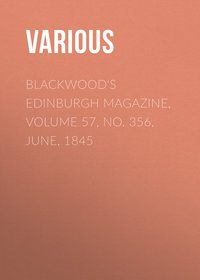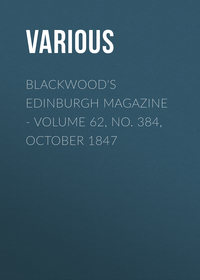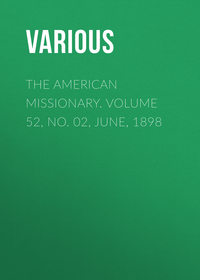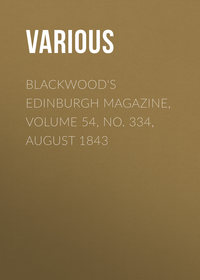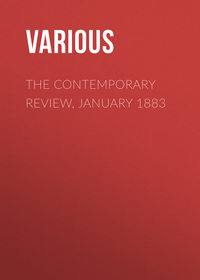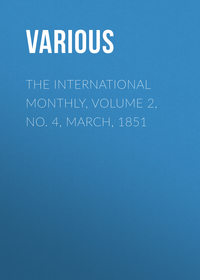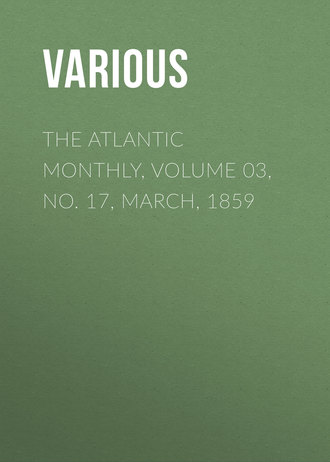 полная версия
полная версияThe Atlantic Monthly, Volume 03, No. 17, March, 1859
But dancing was not one of the regular ceremonies of the Christian Church, even in its corruptest days; and yet dances were performed four hundred years ago in the churches and in church-yards, as a part of, or an appendage to, entertainments of a religious character. These were the Mysteries and Moralities, which are the origin of our drama;—and it is remarkable that in all countries the drama has been at first a religious ceremony. These Mysteries and Moralities were religious plays of the rudest kind: the Mysteries being a representation, partly by dumb show and partly by words, of some well-known incident related in the Bible; and the Moralities, a kind of discussion and enforcement of religious doctrine or moral truth by allegorical personages. They were performed at first almost entirely in the churches, upon scaffolds erected for the purpose.
In a Mystery called "Candlemas Day, or the Killing of the Children of Israel," which represented the Massacre of the Innocents, and in which Herod, Simeon, Joseph, the Virgin Mary, Watkin, a comic character, and Anna the Prophetess, appeared, there was a general dance of all the characters after the Prologue; and at the close of the play, there is a stage-direction for another, in response to a command of Anna the Prophetess, who says,—
"Shewe ye sume plesur as ye can In the worship of Jesu, our Lady, and St. Anne."And thereupon King Herod, Simeon, Joseph, the Virgin Mary, Watkin the funny man, and the Prophetess well stricken in years, proceed to forward four, and end with a promenade all around. Indeed, our ancestors seem to have found it edifying, not to say entertaining, to go to a cathedral to see Satan and an Archbishop dance a hornpipe with the Seven Deadly Sins and the Five Cardinal Virtues.
A Morality called "Every Man," written about 1450, has a direct connection with the subject which we are considering. Every Man, the principal personage of the piece, is an allegorical representation of all mankind; and the purpose of the play is told in this sentence, which introduces it:—
"Here begynneth a Treatyse how the Hye Fader of Heven sendeth Dethe to somon every creature to come & gyve a count of theyr lyves in this worlde, & is in maner of a Morall Playe."
On the title-page of an edition printed in 1500, only one copy of which exists, is a very rude wood-cut, in which an individual, who is labelled "Every Man," is startled at the sight of Death standing at the door of a church and summoning him. In this Moral Play, Fellowship, Good Deeds, Worldly Goods, Knowledge, Beauty, Strength, Discretion, and Five Wittes are characters; and they cannot interpose between Every Man and the summons of Death, nor will any of them, except Good Deeds, go with him. The representation of this play was a kind of Dance of Death, and from the acting of "Every Man" to the execution of that Dance was but a short step.
But the Dance of Death had been performed before "Every Man" was written; and dances in churches and churchyards were of yet greater antiquity. For, by an order of a Roman council under Pope Pius II. in the tenth century, priests were directed "to admonish men and women not to dance and sing in the churches on feast-days, like Pagans." The evil increased, however, until, according to the old chroniclers, a terrible punishment fell upon a party of dancers. One of them, Ubert, tells the story. It was on Christmas Eve, in the time of the Emperor Henry II., who assumed the imperial diadem in the year 1002, that a company of eighteen men and women amused themselves by dancing and singing in the churchyard of St. Magnus, in the diocese of Magdeburg, to the annoyance of a priest who was saying mass in the church. He ordered them to desist; but they danced on in reckless mirth. The holy father then invoked God and St. Magnus to keep them dancing for a whole year; and not in vain. For twelve months they danced in spite of themselves. Neither dew nor rain fell upon them; and their shoes and their clothes were not worn away, although by their dancing they buried themselves waist-high. Yet, fatigued and famished beyond human endurance, they danced on, unable to stop an instant for rest or food. The priest's own daughter was among the dancers; and, unable to undo what the Saint had done, he sent his son to drag her out of the dance. But when her brother pulls her by the arm it comes off in his hand, and he in horror takes it to his father. No blood flows from the wound. The priest buries the arm, and the next morning he finds it upon the top of the grave. He repeats the burial, and with the same result. He makes a third attempt, and the grave casts out the limb with violence before his eyes. Meanwhile the girl and her companions continue dancing, and the Emperor, having heard of this strange occurrence, travels from Rome to see so sad a sight. He orders carpenters to inclose the dancers in a building, but in vain; for that which is built in the day falls down in the night. The dancers have neither rest nor mitigation of their curse until the expiration of the year, when they all rush into the church and fall before the altar in a swoon, from which they are not recovered for three days. Then they immediately flee each other's faces, and wander solitary through the world, still dancing at times in spite of themselves. In the olden time this was believed to be the origin of St. Vitus's dance; but we can now see that the dance is the origin of the story.
The Dance of Death was performed by a large company dressed in the costumes of various classes of society, which were then very marked in their difference. One by one the dancers suddenly and silently slipped off, thus typifying the departure of all mankind at Death's summons. That this Dance was performed, not only with the consent, but by the procurement of the clergy, is made certain by the discovery, in the archives of the Cathedral of Besançon, of the account of the payment of four measures of wine by the seneschal to those persons who performed the Dance Macabre on the 10th of July, 1453.
The moral lesson conveyed by this strange pastime or ceremony seems hardly calculated to secure for it a noteworthy popularity in any age; but for a long time it was, either as a ceremony or as a picture, very popular throughout Europe. We know of forty-four places in which it was painted or sculptured in some large public building, the oldest example being that at Little Bâle, which was painted in 1312. This, like that in Great Bâle, and most of the others, has been destroyed by time or violence. The Dance was made the ornament of books of devotion, and the subject of ornamental initial-letters; groups from it were engraved repeatedly by those fantastic designers and exquisite workmen known as the Little Masters of Germany; a single group was assumed as a device, or trademark, by more than one printer; and it was sung in popular ballads. There is now at Aix-la-Chapelle a huge state-bed-stead, on the posts, sides, and footboards of which it is elaborately carved, in the manner of the sixteenth century; and it was even made the ornament of ladies' fans.
The reasons for this popularity were a certain strange fascination in the subject,—yet not so strange at a time when women would crowd to see men burned or hanged and quartered;—but chiefly, the grand democratic significance of the dance. Death has ever been, and ever will be, the greatest leveller; and at a time when rank had an importance and bestowed advantages of which we can form little idea, while at the same time men had begun to ask why this should be, such a satire as this Dance of Death, sanctioned by the Church, that great protector of established rights and dignities, and yet sparing neither noble nor hierarch, not even the Pope himself, satisfied an eager craving in the breast of poor, envious, self-asserting human nature. In one of those ornamental initial-letters above mentioned, the date of which was some years prior to the execution of Holbein's Dance, Death appears as a grave-digger, and lifts on his spade, out of the grave which he is making, two skulls, one crowned, the other covered with a peasant's hat. He grins with savage glee at seeing these remnants of the two extremes of society side by side; and underneath them, on the shovel, is written Idem,—"The Same." In this word is the key to the popularity of the Dance.
The most important and interesting of these pictured Dances of Death were those at Bâle, at Strasbourg, and at Rouen. That at Bâle consisted of thirty-nine groups, in the first three of which appear a Pope, an Emperor, and a King. These were portraits of Pope Felix V., the Emperor Sigismund, and King Albert II., of Rome, all of whom were present at the Council, by whose order, as we have seen, the Dance was painted. The last group of this Dance shows the seizure of the painter's child by Death. It having been almost destroyed by time, the wall on which it was painted was torn down about a hundred years ago; but engravings had been made of it in the latter part of the seventeenth century. The Dance at Strasbourg, like that at Bâle, and many others, was on the wall of a Dominican convent. It was painted in arched compartments, and is peculiar in that its groups consist of many figures, among whom Death intrudes, and carries off one, generally the principal personage of the company. It was painted about 1450, and probably by the eminent German painter, Martin Schongauer; but having been utterly neglected and forgotten, it was finally plastered over, no one knows when. In repairing the church in 1824, it was accidentally discovered, and carefully exposed; but it was so much injured that it fell into decay soon after drawings had been made from it.
The Dance at Rouen was in the still existing Cemetery of St. Maclou, and was not a painting, but a sculpture. It was not entirely completed until 1526. The cemetery is surrounded by a covered gallery open on the inside, where it was supported by thirty-nine columns, distant about eleven feet from each other. Thirty-one of these still exist; and upon the shaft of all but four of them, on the side facing the court of the cemetery, is sculptured, in high relief, a group of two figures,—one a living personage, and the other the cadaverous body by which Death was represented. On the remainder were sculptured the Christian Virtues and the Fates,—two on each column. The capitals of these columns are decorated with figures quite in another manner. Cupids, naked female figures, grotesque masks, and shapes—human and bestial—are ingeniously substituted for the foliage usually found on that part of a column. The execution of these figures is of quite a high order. They have all been sadly mutilated; but, fortunately, that which has suffered least is a beautiful figure of Eve. Her head is gone; but the flowing lines of the lovely torso are unbroken, and the round and graceful limbs are almost as perfect as when they came from the sculptor's chisel. This figure is so like the Venus de Medici that it might have been copied from it.
But what is Eve doing in a Dance of Death? Alas! she took the first step of that dance in Paradise, and the artists of the olden time did not deprive her of her due precedence. She leads the Dance, but with this difference from those who follow her:—they, cowering and muffled, go off the scene with Death; she, upright in her naked innocence and beauty, brings him on. Poor Eve! she had her punishment and made her atonement to man for leading him to death, in becoming the source and the joy and solace of his life; but it was not for the artists of the Dance of Death to embody this phase of her existence. So essential a part of the Dance is the temptation of Eve, that the whole subject was concentrated into the representation of that event by a German engraver, in this singular manner:—Adam and Eve stand by the Tree of Knowledge, around which twines the serpent, from whom Eve is receiving the apple; but the trunk of the tree is formed by the twisted legs and the ribs of a skeleton, from the head and the outstretched arms of which spring the branches and the foliage. It is worthy of remark, that many painters, the greatest of them (Raphael) at their head, have represented the tempter of Eden as a beautiful woman, whose body terminates in a serpent. It was a mistake on their part to do so. They knew how much of the Devil a woman might have in her, and how irresistible a temptress she is; but they forgot, that, on this occasion, woman, not man, was tempted.
There was a Dance of Death in Old St. Paul's Church, in London,—the one burned down in the Great Fire; and another in the beautiful little parish church of Stratford-on-Avon,—but this, too, has disappeared. It is interesting to know that they were there, and that Shakspeare saw them; for he has woven some of the thoughts that they awakened in his mind into a noble passage in one of his historical plays. We shall recur to it in examining Holbein's Dance.
The Dance was represented, and still exists, in one very singular place. At Lucerne, in Switzerland, it appears upon a covered bridge, in the triangles formed by the beams which support the roof. The groups, of which there are thirty-six, are double, looking away from each other, and are so arranged, that the passenger, on entering the bridge, has before him a long array of these grotesque and gloomy pictures. The motive for placing the Dance in such a place is unknown, and it is difficult to conjecture what it was. It could hardly have been to enforce the old adage,—Speak well of the bridge that carries you over.
* * * * *While we have been thus endeavoring to discover the origin of the Dance of Death, what it was, and what it meant, Holbein has been waiting more patiently than he was wont, for us to see who he was, and why the Dance, which was known three hundred years at least before he was born, is now universally spoken of as his.
Hans Holbein, the greatest painter of the German school, came honestly by his talent and his name. He was the son of Hans Holbein, a painter, who was the son of another Hans Holbein, also a painter. The first Hans was a poor painter; the second a good one; and the third so great, that the world, when it speaks their common name, means only him. The father and grandfather were born at Augsburg, in Bavaria, and of late years it has been asserted by mousing antiquaries that the grandson was born there too; but this, perhaps, is not quite certain; and it is much pleasanter to adhere to the ancient faith, and believe that he was born at that strange old Bâle, in sight of that great Dance, the reproduction, or rather recreation, of which was to make so great a part of his fame,—especially as he was quite surely an inhabitant of the town at such tender years, that the veriest Know-Nothing in the place would not have deprived him of his citizenship.
Of Holbein's life we unfortunately know very little. He showed his talent early, as all the great painters have done. Conscious of his abilities, he devoted himself eagerly to the study of the profession to which his genius urged him. He learned not only painting, but engraving, the sculpture of metals, and architecture; and of all these, it will be remembered, Bâle offered him facilities for study, in examples which must have stimulated both his imagination and his ambition. He did not lack encouragement; for the nobles and burghers of Bâle had begun to acquire a taste for the arts, which their ruder fathers contemned; and they had, at this time, a university in their city, which made them acquainted with Cicero and the orators, of whom Aeneas Sylvius found them so ignorant.
But Holbein, although eminent and well employed, did not thrive. He had some Bâlois failings, and, as Aeneas Sylvius would have said, worshipped Father Bacchus and Dame Venus with too much devotion;—not that he was a drunkard or a debauchee; but he sought in conviviality with men of talent, and in the company of beautiful women, too happy in the caresses of the great painter, who was generous with his florins, that happiness which he could not find at home. For poor Hans was afflicted with what has been the moral and social ruin of many a better, if not greater man than he—a froward, shrill-tongued wife. Luckily, however, the great scholar and philosopher, Erasmus, went into retirement at Bâle, in 1521; and he soon recognized the genius of Holbein, and became his admirer and friend. By his advice, and at the solicitation of an English nobleman, and, poor fellow, seeking refuge from the temper of his wife, whom even the sweet cares of maternity could not mollify, Holbein determined to leave Bâle for England. What was the great cause of Frau Holbein's tantrums,—whether Hans's ears were pierced with conjugal clamors, as poor Albert Dürer's, the other great German painter's, were, because he could not supply all his wife's demands for money, to enable her, perhaps, to exhibit herself at church on holy days in one of those precious pulpits, splendid in velvet and jewels, to the discomfiture of the other painters' wives,—we do not know; but whatever was the cause of her oft-recurring outbreaks, they made him not unwilling to put France and the English Channel between himself and her, his children, and the home of his childhood.
He gave out, at first, that his absence from Bâle would be temporary,—only for the purpose of raising the value of his works, by making them more difficult to obtain. Before he went, he finished and sent home a portrait on which he was engaged. It was one of his best pictures; and the person for whom it was painted, lost for a while in admiration of its beauty, noticed at last that a fly, which had settled upon the forehead, remained there motionless. He stepped up to brush the insect away, and found that it was a part of the picture. This story has, since Holbein's time, been told of many painters,—among others, of Benjamin West. Such a piece of mere imitation should have added nothing to the reputation of a painter of Holbein's powers; but the story was soon told all over Bâle, and orders were given to prevent the loss to the city of so great an artist. But Holbein had quietly gone off, furnished with letters of introduction from Erasmus, who wrote in one of them that in Bâle the arts were chilled; which might well be true of a place where so much ado was made about the painting of a fly.
In England, Holbein found a friend and patron in Sir Thomas More,—Henry the Eighth's great Lord Chancellor; and a sight of some of his works won him, ere long, the favor of the King himself. He was appointed Court Painter, with apartments at the palace, and a yearly salary of two hundred florins, (or thirty pounds, equal to about two hundred pounds now,) which he received in addition to the price of his pictures. After about three years of prosperity he went home to his wife and children; but as he soon returned to England, we may safely conclude that his visit was to provide for the latter, and with no hope of living with the former. Some years after, in 1538, when his fame was still increasing, the city of Bâle, proud of its son, offered him a handsome annuity, in the hope that that might induce him to return to his country, his children, and his wife. But he could not be tempted. Though not the wisest of men, he was Solomon enough to know that "it is better to dwell in a corner of the house-top than with a brawling woman and in a wide house"; and as he was successful and held in honor in England as well as Bâle, he contented himself with a corner of King Henry's palace.
But although he fled from his wife, he painted her portrait; and we need no testimony to warrant the likeness. She is the very type of one of those meek shrews, alternately a martyr and a fury, that drive a man to madness when they speak and to despair when they are silent. We might reasonably wonder that he would paint so vivid a representation of that which he so sedulously shunned. But poor Hans, who probably had some lingering remains of his early love, knew, that, although he should make a speaking likeness, it would be a silent one, and that this Frau Holbein must keep the look which he chose to summon to her face. That, indeed, was knowledge that was power! How he must have chuckled as he saw his wife looking at him more natural than life and yet without the power to worry him! His own portrait shows us a broad, good-natured, ruddy face, in which we see marks of talent when we know that it is Holbein's. But in spite of its strength, its bronze, and its beard, it has a somewhat sad and subdued air; and its heavy-lidded, pensive eyes look deprecatingly at a Frau Holbein in the distance.
While he lived at Greenwich palace, an incident occurred which may not be known to all our readers, and which is a striking illustration of the esteem in which he was held by Henry. It is not a little to the honor of that monarch, who, arbitrary and sensual as he was, had some noble traits of character. One day, as Holbein was painting a lady's portrait in his private studio, a nobleman intruded upon him rudely. Holbein resented the discourtesy, and, as it was doggedly persisted in, finally threw my lord downstairs. There was an outcry; and the painter, bolting his door on the inside, escaped from his window along the eaves of the roof, and, making his way directly to the King, threw himself before him and begged a pardon, without telling his offence. Henry promised forgiveness on condition of a full confession, which the painter began. But meantime the nobleman arrived, and Henry, in deference to his rank, gave him precedence, and stepped into another apartment to hear his story. He accused Holbein of the violence, but suppressed the provocation; whereat Henry broke into a towering Tudor rage, and, after reproaching the nobleman for his prevarication, said, "You have to do with me, Sir. I tell you, that of seven peasants I could make seven earls like you; but of seven earls I could not make one Holbein. Do not molest him, if you value your head." And as second-hand heads, though plentiful about those days, were found to be of no value, even to the original owner, Holbein remained unmolested.
Holbein is known chiefly by his portraits. He painted some historical and sacred pictures; but though they all bear witness to his genius, it can hardly be denied that they also show that that genius was not suited to such works. Holbein had an objective perception;—that is, his mind received impressions entirely uninfluenced by its own character or condition; and his pictures, therefore, seem like literal transcripts of what was before his eyes. He nowhere shows that he had an idea of abstract beauty, or the power of generalizing from individuals, or that he was at all discontented with the subjects which he painted; so that his works leave an impression of absolute faithfulness. But to suppose, therefore, that his portraits have merely the merit of reproducing the external facts of Nature, like photographs, would do him wrong; for he was faithful to expression as well as form, and has perpetuated upon his canvas the voluptuous sweetness of Anne Boleyn, the courtliness and manly grace of Wyatt, and the severity, the energy, and the penetrating judgment of Sir Thomas More. His portrait of the last is one of the greatest portraits ever painted. Some competent critics consider it the greatest. It is so real, so human, that we might be well content, if one in twenty of the actual men we meet were half as real and human; and it expresses, with equal strength and subtilty, the large and noble nature of the man. Holbein was a great colorist, and imitated all the rich and tender hues of Nature, in their delicate and almost imperceptible gradations, with a minute truthfulness which is quite marvellous.
This being the character of his mind, it would hardly be supposed that he could produce such a work as the great Dance of Death, which has caused all others to be forgotten, except by antiquarians. For this Dance is the most remarkable embodiment in Art of that fantastic and grotesque idealism which has found its best expression in the works of German poets and painters; and the preëminence of Holbein's over all the other representations of the same subject consists in this,—that, while they are but a dull and formal succession of mere costumed figures seized by a corpse and shrinking away from its touch, Holbein's groups are instinct with life, character, and emotion. In particular is this true of the figure of Death, although it is a mere skeleton,—the face without a muscle, and for the eye but a rayless cavern. Death is not one whom "a limner would love to paint or a lady to look upon"; but Holbein has given a strange and fascinating interest to the figure, which in all other hands is merely repulsive. The grim monarch sat to a painter who not only added to the truthfulness of his portrait the charm of poetic feeling, but the magic touch of whose pencil made his dry bones live.




